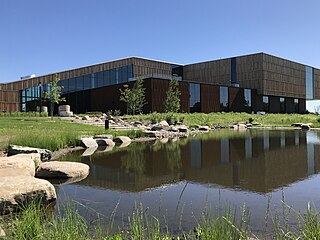Related Research Articles

Ross 128 is a red dwarf in the equatorial zodiac constellation of Virgo, near β Virginis. The apparent magnitude of Ross 128 is 11.13, which is too faint to be seen with the unaided eye. Based upon parallax measurements, the distance of this star from Earth is 11.007 light-years, making it the twelfth closest stellar system to the Solar System. It was first cataloged in 1926 by American astronomer Frank Elmore Ross.

Astrophysics is a science that employs the methods and principles of physics and chemistry in the study of astronomical objects and phenomena. As one of the founders of the discipline, James Keeler, said, Astrophysics "seeks to ascertain the nature of the heavenly bodies, rather than their positions or motions in space–what they are, rather than where they are." Among the subjects studied are the Sun, other stars, galaxies, extrasolar planets, the interstellar medium and the cosmic microwave background. Emissions from these objects are examined across all parts of the electromagnetic spectrum, and the properties examined include luminosity, density, temperature, and chemical composition. Because astrophysics is a very broad subject, astrophysicists apply concepts and methods from many disciplines of physics, including classical mechanics, electromagnetism, statistical mechanics, thermodynamics, quantum mechanics, relativity, nuclear and particle physics, and atomic and molecular physics.

The SETI Institute is a not-for-profit research organization incorporated in 1984 whose mission is to explore, understand, and explain the origin and nature of life in the universe, and to use this knowledge to inspire and guide present and future generations, sharing knowledge with the public, the press, and the government. SETI stands for the "search for extraterrestrial intelligence".

Fiorella Terenzi is an Italian-born astrophysicist, author and recording artist who is best known for taking recordings of radio waves from far-away galaxies and turning them into music. She received her doctorate from the University of Milan but is currently based in the United States.

Neil deGrasse Tyson is an American astrophysicist, author, and science communicator. Tyson studied at Harvard University, the University of Texas at Austin, and Columbia University. From 1991 to 1994, he was a postdoctoral research associate at Princeton University. In 1994, he joined the Hayden Planetarium as a staff scientist and the Princeton faculty as a visiting research scientist and lecturer. In 1996, he became director of the planetarium and oversaw its $210 million reconstruction project, which was completed in 2000. Since 1996, he has remained the director of the Hayden Planetarium at the Rose Center for Earth and Space in New York City. The center is part of the American Museum of Natural History, where Tyson founded the Department of Astrophysics in 1997 and has been a research associate in the department since 2003.

Jennifer J. Wiseman is Senior Project Scientist on the Hubble Space Telescope, and an American astronomer, born in Mountain Home, Arkansas. She earned a bachelor's degree in physics from MIT and a Ph.D. in Astronomy from Harvard University in 1995. Wiseman discovered periodic comet 114P/Wiseman-Skiff while working as an undergraduate search assistant in 1987. Wiseman is a senior astrophysicist at the NASA Goddard Space Flight Center, where she serves as the Senior Project Scientist for the Hubble Space Telescope. She previously headed the Laboratory for Exoplanets and Stellar Astrophysics. She studies star forming regions of our galaxy using radio, optical, and infrared telescopes, with a particular interest in molecular cloud cores, protostars, and outflows. She led a major study that mapped a star forming region in the constellation Orion.
Ray Jayawardhana is the Provost of Johns Hopkins University and a Professor of Physics and Astronomy. Until October 2023, Jayawardhana was the Harold Tanner Dean of the Cornell University College of Arts and Sciences and a Professor of Astronomy at Cornell University, effective September 1, 2018. He was formerly Dean of Science and a Professor of physics & astronomy at York University. Prior to that, he was a Professor of Astronomy & Astrophysics at the University of Toronto, and an Assistant Professor of Astronomy at the University of Michigan. In July 2023, Johns Hopkins University announced that Jayawardhana had been selected as its 16th provost. His primary research areas include the formation and early evolution of stars, brown dwarfs and planets. His current research focuses on characterizing exoplanets using telescopes on the ground and in space.
Rebecca Oppenheimer is an American astrophysicist and one of four curator/professors in the Department of Astrophysics at the American Museum of Natural History (AMNH) on Manhattan's Upper West Side. Oppenheimer is a comparative exoplanetary scientist. She investigates planets orbiting stars other than the Sun. Her optics laboratory is the birthplace of a number of new astronomical instruments designed to tackle the problem of directly seeing and taking spectra of nearby solar systems with exoplanets and studying their composition, with the ultimate goal of finding life outside the solar system.

The Bell Museum, formerly known as the James Ford Bell Museum of Natural History, is located at the University of Minnesota's Saint Paul campus. The museum's current location on the Saint Paul campus opened in 2018. The Minnesota wildlife dioramas showcase animal specimens from around the world. The museum also houses the digital Whitney and Elizabeth MacMillan Planetarium. The museum is part of the university's College of Food, Agricultural and Natural Resource Sciences. The museum's former location on University of Minnesota's Minneapolis campus closed in January 2017.

Heidi B. Hammel is a planetary astronomer who has extensively studied Neptune and Uranus. She was part of the team imaging Neptune from Voyager 2 in 1989. She led the team using the Hubble Space Telescope to view Shoemaker-Levy 9's impact with Jupiter in 1994. She has used the Hubble Space Telescope and the Keck Telescope to study Uranus and Neptune, discovering new information about dark spots, planetary storms and Uranus' rings. In 2002, she was selected as an interdisciplinary scientist for the James Webb Space Telescope.

Kappa Andromedae b is a directly imaged substellar object and likely superjovian-mass planet orbiting Kappa Andromedae, a young B9IV star in the Andromeda constellation, about 170 light-years away. The companion's mass is roughly 13 times the mass of Jupiter. As early history on Kappa And b is filled with debate over whether it is an exoplanet or a brown dwarf, some scientists have broadly described it as a "super-Jupiter" object.
The Carl Sagan Institute: Pale Blue Dot and Beyond was founded in 2014 at Cornell University in Ithaca, New York to further the search for habitable planets and moons in and outside the Solar System. It is focused on the characterization of exoplanets and the instruments to search for signs of life in the universe. The founder and current director of the institute is astronomer Lisa Kaltenegger.

Sarah Ballard is an American astronomer who is a professor at the University of Florida. She has been a Torres Fellow at the Massachusetts Institute of Technology, a L'Oreal Fellow, and a NASA Carl Sagan Fellow.
Dorothy Agnes Bennett was an American anthropologist, astronomer, curator, publisher, and author. She was the first assistant curator of the Hayden Planetarium, and co-created the Little Golden Books franchise.
Aomawa L. Shields is an associate professor of physics and astronomy at UC Irvine. Her research is focused on exploring the climate and habitability of small exoplanets, using data from observatories including NASA's Kepler spacecraft. Shields was a 2015 TED Fellow, and is active in science communication and outreach. She develops interactive workshops to encourage self-esteem and teach about astronomy, combines her training in theater and her career in astronomy.

The Habitable Exoplanet Observatory (HabEx) is a space telescope concept that would be optimized to search for and image Earth-size habitable exoplanets in the habitable zones of their stars, where liquid water can exist. HabEx would aim to understand how common terrestrial worlds beyond the Solar System may be and determine the range of their characteristics. It would be an optical, UV and infrared telescope that would also use spectrographs to study planetary atmospheres and eclipse starlight with either an internal coronagraph or an external starshade.

Denise C. Nuttall Stephens is an associate professor of astronomy in the College of Physical and Mathematical Sciences in the Department of Physics and Astronomy at Brigham Young University.
Charles Tsun-Chu Liu is an American astronomer and astronomy educator. His research interests include merging and colliding galaxies, active galactic nuclei, and the star formation history of the universe. He is a former director of the William E. Macaulay Honors College and The Verrazano School at the City University of New York's College of Staten Island. He currently serves as a professor of physics and astronomy at the College of Staten Island, and as President of the Astronomical Society of New York. In 2019, he was named a Fellow of the American Astronomical Society.
Eileen Gonzales is an American astrophysicist and postdoctoral fellow at the Department of Astronomy at Cornell University, where her research focuses on exoplanets and brown dwarfs. She is also a co-founder and lead organizer of #BlackInPhysics, a campaign to recognize and celebrate Black physicists and amplify their work.
Jacqueline K. (Jackie) Faherty is an American astronomer specializing in infrared astronomy and the observation of nearby stars and brown dwarfs, and known for her public outreach in space science. She works at the American Museum of Natural History as a senior scientist in the museum's Department of Astrophysics and a senior education manager in the Department of Education.
References
- 1 2 Hanson, Alex. "Astrophysics, Fashion, and DJ Carly Sagan: An Interview with Emily Rice" [ permanent dead link ], HERpothesis , 20 January 2016. Retrieved on 5 November 2016.
- 1 2 3 4 5 6 "Staff Directory - Emily Rice". American Museum of Natural History.
- ↑ "Faculty Directory - Emily Rice". City University of New York. Archived from the original on 2016-04-26. Retrieved 2016-11-05.
- 1 2 3 4 Rice, Emily. "Emily L. Rice - UCLA Astronomy". www.astro.ucla.edu. Retrieved 5 November 2016.
- 1 2 3 4 5 "Faculty Alpha List - Emily Rice". City University of New York. Archived from the original on 2016-04-26. Retrieved 2016-11-05.
- 1 2 3 4 5 "About Emily Rice". Star Talk.
- ↑ Rice, Emily; Ash, Summer. "STARtorialist". startorialist.com.
- ↑ "Astronomy On Tap". astronomyontap.org.